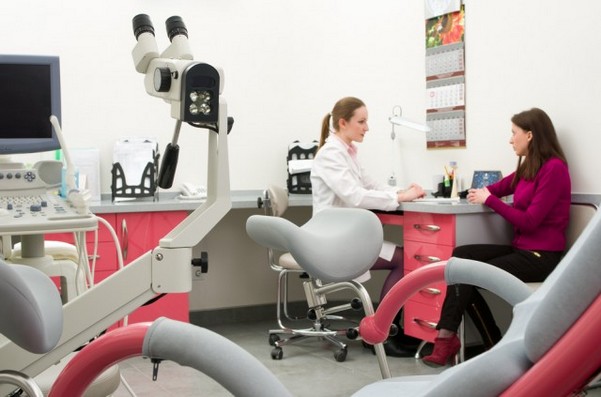Restoration of the menstrual cycle after childbirth. Having scanty periods: what is the cause of this condition.
The age mark of “forty years” scares many women not only physiologically, but also psychologically. At this age, menopause should not yet occur, but its onset is quite likely within a few years. And if before this period the menstrual cycle occurred without disturbances and regularly, then scanty periods at 40 years old, the reasons for this can quite frighten a woman.
When a patient is worried about scanty periods after 40, the reasons may be different. However, the most common among them are menopause and pathology.
Menopause or menopause usually occurs when a woman is 50 years old. By this time, hormone production decreases, cell renewal does not occur as quickly as before. Menopause is very natural for women, but everyone experiences it differently. For example, menopause can cause mood swings, blood pressure surges, and sometimes poor health. When menopause occurs, doctors recommend seeking advice from a gynecologist and describing to him your physical and psychological condition in as much detail as possible.
The number 50 for women may seem difficult not so physically, but it will also have a strong impact on her psyche. To avoid depression, excessive irritability and drowsiness, the attending physician will prescribe sedatives that will maintain peace of mind.
The second reason for scanty periods after 40 years may be hidden in pathology. This condition is most clearly characterized by an irregular menstrual cycle. In most cases, it is accompanied by copious discharge of blood along with mucus. Usually, poor health is accompanied by sharp pain in the abdominal area.
With scanty periods, doctors can diagnose several diseases. The most common is a disease called endometriosis.
It is characterized by the movement of the mucous layer of the uterus to other pelvic organs. When menstruation occurs, it happens profuse bleeding due to the rejection of these areas. With endometriosis, menstruation is characterized by irregularity, severe pain, and copious amounts of blood. This disease often occurs in women who have had more than one abortion or curettage.
The female body is individual. There are cases when, with endometriosis, the first two to three days of women are bothered by scanty menstruation, but this is always followed by heavy menstruation bleeding. However, such cases are not common.
At the age of forty, scanty periods, that is, a decrease in the volume of discharge, may be a sign of decreased ovarian function. This period is characterized by rapid heartbeat, general malaise, drowsiness, sometimes dizziness, and mood swings. Often women during such periods suffer from insomnia and headaches.
Symptoms also appear on the skin. Thus, in most patients, the skin becomes dry and wrinkled. Sometimes hair not only begins to turn gray faster, but also falls out. The previous figure takes on slightly different forms.
Menstruation becomes more and more scanty, and itching, burning, and a feeling of dryness appear in the genital area.
In what cases should you consult a doctor?
 It is necessary to visit a gynecologist several times a year. However, often, citing busyness and a lot of worries, women ignore this rule. At best, they make an appointment with a specialist only when visible symptoms of the disease occur.
It is necessary to visit a gynecologist several times a year. However, often, citing busyness and a lot of worries, women ignore this rule. At best, they make an appointment with a specialist only when visible symptoms of the disease occur.
However, the age of 40-50 years is the most vulnerable for the female body, so visiting a doctor for regular examinations is simply necessary. If this period lasts more than six days, and basal temperature continues to grow, there is no way to do without consultation. Indeed, against the background of these symptoms, inflammatory processes in the female genital organs, as well as oncological diseases.
What symptoms can tell you
If the same year and month has arrived when the above-described symptoms make themselves felt, then most likely it is menopause. At the same time, signs such as fever, weakness and mood changes may indicate other changes in the body.
For example, they often indicate pregnancy. Moreover, in women of this age category, all known signs are clearly expressed. This is a strange taste in the mouth, swollen breasts, a completely new perception of familiar smells, and so on.
Changes in the female body may also indicate disorders that are associated with stress. Resistance to unpleasant situations only decreases with age.
Changes menstrual cycle are very sensitive and often depend on an incorrect nutritional system, in which the body does not receive enough fats, proteins and carbohydrates. Also, such changes may indicate uterine fibroids, inflammatory processes of the female appendages. 
At the same time, scanty menstruation can also develop against the background of other, more serious diseases. These are, first of all, diabetes mellitus, liver cirrhosis, and urolithiasis. Insufficient menstruation can also occur as a result of infectious diseases, operations, diseases affecting the respiratory tract, etc.
If at this age menstrual flow is completely absent, then this, as a rule, indicates hormonal disorders in the body. In such cases, the doctor prescribes a blood test for the presence of luteinizing hormone, estradiol or FSH. If one of them is missing, the doctor prescribes appropriate treatment.
Any changes in the menstrual cycle in a woman of childbearing age may already indicate a deviation or pathology. The condition of the female body is influenced by both physical and psychological factors.
Often women, due to their busyness and constant running around, do not think about how their menstruation goes. However, it is the regularity of the cycle, normal volumes of discharge and the duration of the periods themselves that are the main indicators of the health status of women. If there is the slightest change in these processes, you should consult a doctor.
Treatment must be started on time and will depend on what diagnosis the patient is given. The doctor makes a conclusion based on the results of the survey, examination and tests. If necessary, he can also prescribe additional procedures - ultrasound of the female genital organs, examination of the material of the uterine cavity, endometrium, etc.
There are not many reasons why a woman might be alarmed by scanty periods. However, you should not try to diagnose yourself and fix the problem yourself. In such cases, it is better to consult a doctor who will determine the correct cause of the changes.
We recommend similar articles
Scanty periods do not cause many problems and, as a rule, women pay little attention to them. Often a woman does not particularly attach importance to the importance of the nature of this discharge, content with the fact that menstruation comes on time and corresponds to cyclicity. And in vain, since the amount secreted during menstruation is of great importance and allows us to assess the functionality of the reproductive organs. A disruption of the cycle, when blood loss occurs with a significant decrease from the accepted norm (less than 50 ml), is called hypomenorrhea in the science of gynecology.
Reasons after 40 years
Hypomenorrhea is characterized by discharge as blood drops or simply traces of blood with a brown tint. The duration of menstruation is also reduced, which is a sign of oligomenorrhea or the onset of amenorrhea with a complete cessation of menstrual symptoms. Scanty periods may be a consequence of the formation of the reproductive system or, conversely, be evidence of the onset of menopause in a woman. Also, the occurrence of scanty periods can serve as a sign of a pathological disorder in the reproductive system. The treatment of this deviation directly depends on the factors that caused it.
Scanty periods signal disturbances in the natural processes occurring in the reproductive sphere of women. Being directly dependent on female age, the reasons can differ significantly from each other and have not only a character inherent in the pathological process, but have an absolutely physiological nature. For example, in youth, when primary menstruation has already occurred, and the cycle itself remains unsettled, for one year menstruation may not be cyclical and appear intermittently, and they will also have rather insignificant discharge. Menstruation during this period may occur only a few times throughout the year and, as a rule, will have the character of scanty periods. There is no need to react violently to such violations, since everything will return to normal within one year. If this does not happen over a long period, and the cycle remains irregular with scanty discharge, we can safely draw conclusions about menstrual dysfunction.
 Scanty monthly discharge at the time of the decline of a woman’s reproductive functions during premenopause can be safely attributed to physiological reasons. This period of menopause is a preliminary stage before the complete cessation of menstruation, and lasts on average up to 2 years. Physiological reasons for scanty periods during this important transition period in a woman’s life may be present, but they are not mandatory.
Scanty monthly discharge at the time of the decline of a woman’s reproductive functions during premenopause can be safely attributed to physiological reasons. This period of menopause is a preliminary stage before the complete cessation of menstruation, and lasts on average up to 2 years. Physiological reasons for scanty periods during this important transition period in a woman’s life may be present, but they are not mandatory.
The scanty manifestation of menstruation is divided into the primary form of hypomenorrhea, in which a woman has never had full menstruation with a normal amount of discharge. Typically, this pathology is found in young teenage girls during adolescence, especially if they begin to limit themselves in nutrition in order to lose weight. These deviations can also occur in the case of congenital anomalies in the unformed reproductive system, as well as due to delays in general development or in the development of the genital organs, as well as with an asthenic physique.
Secondary hypomenorrhea occurs when a woman’s menstruation was normal, and then, for a number of reasons, began to be scanty.
Main symptoms
Hypomenorrhea often does not show clear symptoms and a woman may not show concern about this abnormality for a long time. The appearance of scanty menstrual discharge often even suits women, simplifying the hygienic care of the genitals during this period. Minor bleeding may not even be mistaken for menstruation, but ignored, although such a violation of reproductive functions has a number of special signs, for example:
- feeling unwell;
- the appearance of persistent headaches;
- nagging pain in the chest may occur;
- vomiting and nausea;
- nosebleeds;
- unstable psycho-emotional state.
 The most common symptoms inherent in this condition include pain in the pelvic area, which has the nature of spasms and is quite intense, as well as the appearance of pain in the lumbar region, which often has a bilateral distribution. These disorders occur due to a decrease in estrogen levels, leading to loss of sexual desire.
The most common symptoms inherent in this condition include pain in the pelvic area, which has the nature of spasms and is quite intense, as well as the appearance of pain in the lumbar region, which often has a bilateral distribution. These disorders occur due to a decrease in estrogen levels, leading to loss of sexual desire.
Mechanisms of hypomenorrhea
At the end of the last phase of the menstrual cycle, the endometrial mucosa is shed and removed from the uterine cavity along with menstrual blood. Normally, monthly discharge is painless, lasts no more than 5 days, and the pause between them ranges from 20 to 35 days. The amount released should not be less than 50 ml and not exceed 150 ml. Deviation from these indicators serves as evidence of reproductive dysfunction and the occurrence of pathological processes in the menstrual system of the female body.
Violations of such functions may be caused by the following conditions:
- Hypomenorrhea with its inherent scanty periods, when the volume of blood released during menstruation does not exceed 50 ml;
- Oligomenorrhea, in which the duration of menstruation decreases;
- Opsomenorea, in which the pause between regular menstruation exceeds 5–8 weeks;
- Spaniomenorea, characterized by very rare occurrences of menstruation, no more than 4 during the year.
Oligomenorrhea is most often combined with the manifestation of scanty menstrual discharge and, as a rule, is considered a prerequisite for the subsequent occurrence of an increased interval and rare occurrence of menstruation.
The presence of hypomenorrhea belongs to the mildest form of the appearance of scanty menstrual discharge. Much greater concern is caused by the subsequent condition - spaniomenorrhea, which has the character of very scanty discharge with menstruation and, in fact, is the result of untreated previous conditions.
Main causes of hypomenorrhea
 To establish the specific cause of the pathological deviation in the form of scanty menstrual discharge, it is necessary to understand what type of form it belongs to, primary or secondary. The primary type of form is caused by pathological disorders in the structure of the internal genital organs, or deviations and delays in the development of the psyche. However, under the influence of fashion trends, girls experience scanty periods due to insufficient body weight, who, in pursuit of an ideal figure, limit their diet in every possible way. Due to an insufficient amount of adipose tissue, the amount of estrogen hormones decreases, which has a direct impact on the functions of the reproductive system of women.
To establish the specific cause of the pathological deviation in the form of scanty menstrual discharge, it is necessary to understand what type of form it belongs to, primary or secondary. The primary type of form is caused by pathological disorders in the structure of the internal genital organs, or deviations and delays in the development of the psyche. However, under the influence of fashion trends, girls experience scanty periods due to insufficient body weight, who, in pursuit of an ideal figure, limit their diet in every possible way. Due to an insufficient amount of adipose tissue, the amount of estrogen hormones decreases, which has a direct impact on the functions of the reproductive system of women.
Secondary causes of hypomenorrhea include many reasons. This can also be caused by a narrowing of the lumen of the uterine cervix, which occurs due to its injury during surgery or as a result of infectious processes, when the decrease in the lumen in the cerebral canal is simply not able to allow menstrual flow to pass through. The reason may also be insufficiency of the endometrial layer, subsequently reducing its area of distribution. Diseases of the endocrine system can also contribute to hormonal imbalances occurring in women's bodies. Significant fluctuations in body weight can be safely attributed to one of the reasons for poor discharge, as well as numerous disturbances in existence in the form of stress, long-term emotional overload, insufficient nutrition with a small amount of vitamins and minerals necessary for a woman. Long-term use of hormonal contraceptives used orally can also provoke the appearance of scanty periods in women.
Frequently occurring infectious processes and viral diseases can disrupt the hormonal balance in the female body and thereby cause disturbances in reproductive functions. A disruption of the circulatory system in the uterine cavity can disrupt the processes of full development of the mucous layer, which can also lead to menstruation disorders. During periods breastfeeding Often there is the appearance of such a disorder as scanty periods, up to their complete cessation. And finally, unfavorable environment, increased background radiation, harmful working conditions with the use of toxic substances also adversely affect reproductive capabilities and the nature of the menstrual cycle.
Many patients ask why menstruation, having insufficient volume, also acquires a brownish color. At the stage of childbearing age, the cause of this pathology lies in the dysfunction of the ovaries and the part of the brain - the pituitary gland, which directly affects menstrual cyclicity. Frequent abortions or the use of repeated diagnostic curettages can also disrupt the mucous membrane in the endometrium. Serious chronic diseases not related to the sexual sphere, for example, tuberculosis, disrupt the blood supply to the uterus and cause cycle disorders. Often the brownish tint of the discharge is acquired due to illiterately selected contraceptives that are not suitable for the body.
Treatment of abnormalities
If you detect signs of hypomenorrhea in any form, you should immediately consult a gynecologist. Even with full confidence in the causes of such a pathological deviation and with full opportunity to cope with it on your own, you need to trust a specialist. Restoring cyclicity and the appearance of full menstruation is possible only after eliminating all the causes contributing to the occurrence of this pathology. To achieve this, you need to conduct a thorough diagnosis and a complete examination using various techniques.
 Treatment for reducing discharge during menstruation is carried out only after a definitive diagnosis, when there is no doubt about the nature of the pathology. The doctor prescribes a complex of vitamins and, if necessary, the use of hormonal treatment. If the condition is due to an infectious inflammatory process, the gynecologist will prescribe appropriate antimicrobial agents. As a rule, discharge with a brown tint is evidence of diseases of the genital organs of various types, and the methods used in treatment should be aimed specifically at eliminating these diseases. In addition, it is necessary to carry out a course of restorative procedures, such as:
Treatment for reducing discharge during menstruation is carried out only after a definitive diagnosis, when there is no doubt about the nature of the pathology. The doctor prescribes a complex of vitamins and, if necessary, the use of hormonal treatment. If the condition is due to an infectious inflammatory process, the gynecologist will prescribe appropriate antimicrobial agents. As a rule, discharge with a brown tint is evidence of diseases of the genital organs of various types, and the methods used in treatment should be aimed specifically at eliminating these diseases. In addition, it is necessary to carry out a course of restorative procedures, such as:
- massage using acupressure;
- aromatherapy techniques using oils appropriate for this condition, for example, the use of marjoram and juniper oil increases the possibility of the formation of sex hormones in a woman’s body;
- the use of color therapy with a predominance of yellow;
- foot baths with hot water a week before the start of your next menstruation, but in no case during it.
Poor menstruation during pregnancy
Sometimes pregnancy can be accompanied by scanty discharge mixed with blood, vaguely reminiscent of menstruation. This condition should alert the woman, as it is an alarming signal indicating the onset of premature placental abruption, which threatens miscarriage. A woman in such a situation is urgently placed in a hospital setting under the supervision of a gynecologist. All measures are taken to preserve the fetus and stop the development of further processes.
Diagnostic methods
In order to assess the condition that has arisen and its danger for a woman and to identify all possible causes of scanty periods, patients need to undergo a full examination according to a specially designed scheme, including the following techniques:

The outcome of favorable treatment of hypomenorrhea directly depends on the results of the diagnosis. If these disorders were caused by an incorrect diet, excessive physical activity or psycho-emotional state, the essence of treatment in such a situation is to eliminate the causes that led to it. On the recommendation of a specialist, if necessary, the condition is corrected with the help of hormonal medications, vitamin complexes and antiviral agents.
The main emphasis in treatment is focused on eliminating the underlying pathological process and carrying out restorative procedures. Homeopathic medicines can significantly improve a woman’s well-being, having an effect similar to the effects of hormones produced in her own body. In cases in which hypomenorrhea is accompanied by such manifestations as depression, attacks of apathy, headaches and muscle pain, loss of sexual desire, it is necessary to use physiotherapeutic methods of treatment and the help of a psychotherapist aimed at limiting such deviations.
 If such a deviation appears as scanty periods at the time of premenopause or during breastfeeding, no special treatment methods are carried out, since one condition is considered normal, and the second will soon go away on its own after stopping feeding.
If such a deviation appears as scanty periods at the time of premenopause or during breastfeeding, no special treatment methods are carried out, since one condition is considered normal, and the second will soon go away on its own after stopping feeding.
Prevention
In conclusion, it would be useful to think about measures to prevent the appearance of scanty discharge during menstruation, since the best treatment is proper prevention.
Try to change your lifestyle if possible, spend more time in the fresh air, get rid of bad habits and not overexert yourself. Watch your diet; excess weight can cause scanty menstruation. Long-term stressful situations can also lead to hormonal instability, so if such cases cannot be avoided, you need to learn to relax and let go of the situation without accumulating negativity. It is not recommended to abuse various dietary restrictions and eat fresh onions and garlic more often.
It is known that the menstrual cycle is an important indicator women's health. Beginning in adolescence, menstruation indicates the final formation of reproductive function. From now on, the girl can become a mother. After 40–50 years, this opportunity is gradually lost - the hormonal system undergoes age-related changes, and menstruation disappears.
All women of reproductive age have probably experienced menstrual irregularities. This can become an obstacle to pregnancy, and therefore represents serious problem in gynecology. One of these conditions is frequent menstruation or polymenorrhea. When complaining to a doctor, women want to find out what is the cause of the problems and how they can be eliminated.
When menstruation occurs too often, you need to consult a gynecologist to find out why this is happening.
Causes and mechanism of development
Frequent periods in most cases appear as a result of a violation of the complex relationships between the regulators of the menstrual cycle. They are based on hormonal imbalance, which can occur at any level - hypothalamus, pituitary gland, ovaries - and is manifested by structural changes in the uterine mucosa (endometrium). This is typical to varying degrees for both young girls and women over 40 years of age.
The menstrual cycle consists of two phases: follicular and luteal. It begins with the release of blood, which is exfoliated endometrium. At the same time, under the influence of pituitary hormones, a follicle with an egg matures in the ovary. This process continues for exactly half the cycle, and menstruation ends normally in 7–10 days. At the end of the first phase, ovulation occurs - the follicle ruptures and the egg is released. From this moment on, the corpus luteum matures in the ovary, which secretes progesterone, necessary for the development of pregnancy. If fertilization does not occur, then the luteal phase ends with the next menstruation.
The cause of polymenorrhea may be hidden behind disturbances in any part of the cycle. This most often occurs in the following conditions:
- Hormonal changes.
- Inflammatory diseases (salpingoophoritis, endometritis).
- Tumors (fibroids, cysts, polyps).
- Endometriosis.
- General diseases (diabetes mellitus, thyroid pathology, liver cirrhosis).
- Taking oral contraceptives.
Frequent periods can occur not only due to functional disorders - structural changes in the woman’s reproductive system are also of great importance.
In order to eliminate the cause of polymenorrhea in a timely manner, you should not rely on the ability to restore the cycle on your own, but rather undergo an examination by a doctor.
Symptoms
Normally, menstruation occurs at the same frequency with an error of 10 days. If discharge appears in less than 21 days, then we can talk about polymenorrhea. But such a disorder is characterized not only by a shortening of the interval between menstruation. Other menstrual irregularities may also appear:
- Heavy and prolonged periods – hypermenorrhea or menorrhagia.
- A short menstrual cycle is pseudopolymenorrhea.
- Scanty periods – oligomenorrhea.
- Uterine bleeding – metrorrhagia.
- Lack of ovulation (anovulation).
Such cycle features are observed when various pathologies, and therefore, to accurately determine their cause, it is necessary to carry out competent differential diagnosis. A clinical examination of the woman by a gynecologist with the necessary additional funds will help with this.
Hormonal changes
Polymenorrhea often appears as a result of physiological changes at different periods of a woman’s life. At puberty, when the cycle has not yet stabilized, frequent periods can be completely normal. In women after 40–45 years of age, premenopause occurs, when the amount of estrogen decreases, which is accompanied by a change in the frequency and duration of menstruation.
In addition, women of different ages may experience ovarian dysfunction, which is characterized by:
- Delayed menstruation, heavy or, conversely, scanty discharge.
- Intermenstrual bleeding.
- Pain in the lower abdomen.
- Phenomena of premenstrual syndrome.
This is a fairly common occurrence and occurs under the influence of many external or internal factors: ranging from physical or emotional fatigue, climate change, incorrect intrauterine device and ending with serious endocrine disorders.
If a woman notices that her periods are coming more often than usual, she should first consult a doctor, as this may be the result of certain health problems.
Inflammatory diseases

The menstrual cycle quickly responds to inflammatory processes in the woman’s reproductive system. Such disturbances are especially pronounced when the ovaries and uterus are affected. When salpingoophoritis (inflammation of the appendages) or endometritis develops, along with polymenorrhea, the following may be present to varying degrees:
- Aching pain in the lower abdomen radiating to the rectum.
- Various discharge: cloudy, white-yellow or greenish in color, with an unpleasant odor.
- Itching and burning in the vagina.
- Increased body temperature.
- Pain during palpation of the abdomen and gynecological examination.
Long-term inflammatory diseases lead to the formation of adhesions, which, in combination with hormonal disorders become common cause female infertility.
Tumors

Diseases of the uterus of a tumor nature are more common in women over 40 years of age. Frequent menstruation is mainly observed with submucosal fibroids and polyps, when the process of rejection of the functional layer of the endometrium is disrupted. Then you can notice:
- Copious discharge.
- Bleeding between periods.
- Increased size of the uterus upon examination.
- Chronic anemia.
During menopause, a dangerous symptom is the appearance of menstruation starting again - this may be a sign of uterine cancer. Ovarian cysts also lead to menstrual irregularities. If there is a disturbance in the release of progesterone, menstruation occurs more often, since the time interval between them is reduced.
Polymenorrhea in women after 50 years of age can indicate a serious pathology, which often poses a real threat to the health and life of a woman.
Treatment

Having found out why a woman has frequent periods, it is necessary to carry out adequate treatment. Physiological changes, of course, do not require active intervention, but sometimes some correction may be required to ensure the smooth passage of such a period. Basically, you need to pay attention to the treatment of pathological conditions accompanied by polymenorrhea. Conservative or surgical methods can be used.
Conservative methods
Most pathologies respond well to conservative treatment. This applies to dysfunctional disorders, inflammatory diseases, early stages of endometriosis and general pathology. The basis of therapeutic measures is the use of medications. Depending on the situation, the following drugs are applicable:
- Combined oral contraceptives with different ratios of progesterone and estrogen.
- Antibiotics.
- Hemostatic.
- Iron supplements.
In many cases, to normalize the menstrual cycle, it is recommended to change your lifestyle: eat right, give up bad habits, lose weight, and ensure adequate physical activity.
Operative methods

If a uterine tumor is detected in women after 50 years of age, treatment tactics depend on its type and distribution. For polyps or small submucosal fibroids, they are removed by resection or enucleation. If the formation is large, it is necessary to amputate the uterus. In the case of malignant pathology, extended extirpation of the appendages and nearby lymph nodes is used, and after that, radiotherapy or chemotherapy.
If ovarian cysts are not associated with functional changes, they must also be removed, since there is a risk of their malignancy. In this case, laparoscopic surgical techniques are used. When a woman has peritoneal endometriosis, cauterization of pathological foci (coagulation) can be performed in this way.
Young girls and women over 40 need to pay attention to polymenorrhea, since this can be not only the result of physiological changes, but also serious pathology. In the latter case, you need to start treatment with a specialist in a timely manner.
Scanty periods after childbirth are not uncommon. They are called scanty because the cycle is not disrupted, that is, they come every month, but the discharge is in small quantities. Sometimes there is a decrease in the days of the cycle and pain in the lower abdomen. In this case, you should not attribute everything to physiology; it is better to inform the doctor in time and undergo the necessary diagnostics.

Scanty periods
Scanty periods after childbirth are a common occurrence. This is a physiological state when female body I have not yet fully adjusted to the normal cycle. As a rule, over time, everything improves on its own; only a short period of time is needed.
But with long, scanty menstruation, which does not change each time, you need to see a doctor, most likely there is an infection in the body. Sometimes scanty periods occur as a result of stress during childbirth or breastfeeding.

- The mammary glands do not feel pain.
- The color of the discharge is brown.
- The frequency of discharge is irregular.
- There is no pain.
- Bloody discharge drops or smears.
If there are no other deviations, then everything is going according to plan and no medical intervention is required. After a certain time, everything will change and the menstrual cycle will be restored.
But if a woman observes discharge that is too dark, one might even say black, especially if she managed to give birth through C-section, you should immediately seek medical help. This may indicate blood clots in the uterus. This will require extensive treatment. medicines and sanitation of the cervix and vagina.
Lochia after childbirth
Lochia is postpartum bloody discharge. They are most often moderate, reminiscent of menstruation in last days. They last 10 days, after which the discharge changes its appearance and transforms into a mucous-bloody form. After 2 weeks, leucorrhoea begins to appear. If you look at these secretions through a microscope, it turns out that there are no red blood cells there anymore. They consist of desquamated epithelial cells from the inside of the uterus.
In rare cases, lochia continues for up to 42 days with a gradual decrease in the amount of blood released. Bleeding after childbirth is considered a condition when a woman is forced to change the pad every hour. In this case, it is necessary to urgently inform the doctor about this, since this is not considered the norm and can threaten not only the health, but also the life of the woman.

If, after curettage, scanty periods are accompanied by an unpleasant odor, the discharge is too dark in color, there is pain in the lower abdomen, and the temperature is higher than normal, then you should immediately consult a doctor. The most common reason for this is improper scraping. After it, particles of the fetal membrane may remain in the uterus. In this case, repeated curettage will be required.

How long does it take for the first menstruation to appear after childbirth?
During pregnancy, the endocrine system of the expectant mother actively produces the hormone progesterone. It is also called the pregnancy hormone. After childbirth, the body undergoes a restructuring in a new way. Therefore, there is a delay in the outflow of menstrual blood and a moderate menstrual cycle is observed.
Temporary cessation of menstruation is associated with hormonal changes. The recovery period takes place individually in each case. On average, its indicator is three months.

Restoring the menstrual cycle after childbirth
To help the body quickly and without consequences restore the menstrual cycle, you must adhere to some rules:
- The daily routine needs to be properly organized.
- Always rest after doing any work.
- Meals should be timely and balanced.
- You shouldn’t be nervous about anything, you need to avoid stressful situations.
- Make sure there are no postpartum complications.
- Treat all diseases in a timely manner so that they do not become chronic.
The first periods may be scanty due to excessive production of prolactin, which appears for two main reasons:
- The appearance of a benign prolactinoma tumor, which is responsible for milk production.
- Diseases associated with endocrine disorders.
If after childbirth there are no periods for a long time, other suspicious symptoms appear, for example, scanty periods, alternating heavy ones, with blood clots, severe pain, etc., consult a doctor as soon as possible, since delay can be fraught with dangerous consequences.
And a little about secrets...
Have you ever suffered from problems with Menstrual cycle? Judging by the fact that you are reading this article, victory was not on your side. And of course you know firsthand what it is:
- copious or scanty discharge with clots
- pain in the chest and lower back
- pain during sex
- bad smell
- discomfort when urinating
Now answer the question: are you satisfied with this? Can problems be tolerated? How much money have you already wasted on ineffective treatment? That's right - it's time to end this! Do you agree? That is why we decided to publish an interview with the chief gynecologist of Russia, Leila Adamova, in which she revealed the simple secret of normalizing the menstrual cycle.




